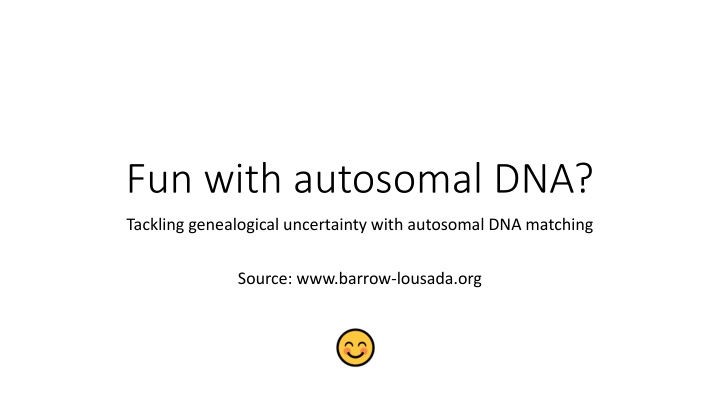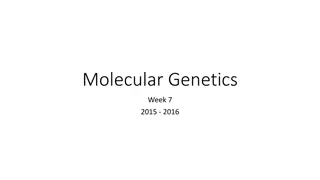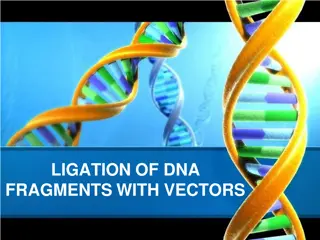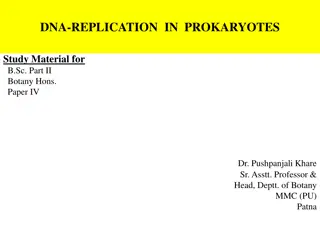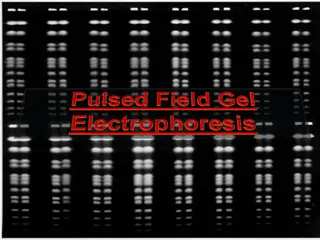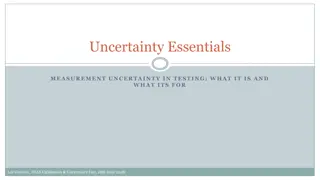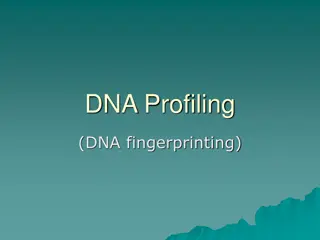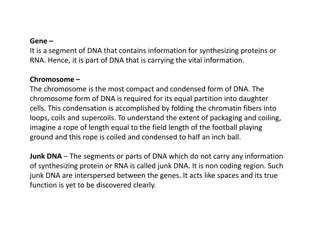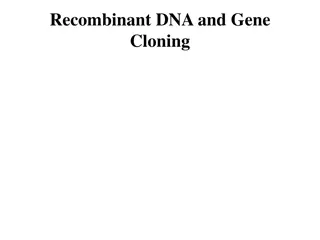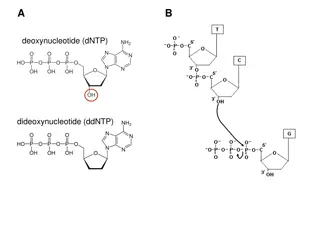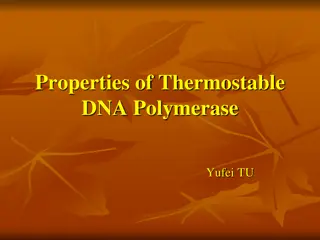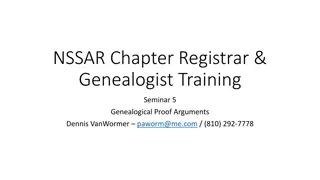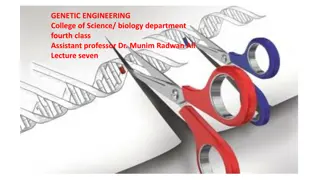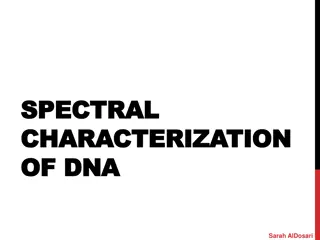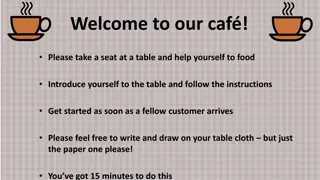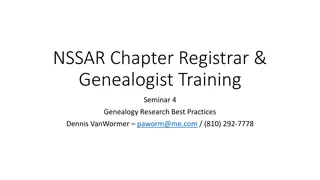Tackling Genealogical Uncertainty with Autosomal DNA Matching
Autosomal DNA matching is a powerful tool for deciphering complex genealogical puzzles and unraveling familial connections. This article delves into the challenges and nuances of using autosomal DNA data, exploring how matches can aid in tracing lineage back generations. With a focus on confirming the Baruch Lousada family tree and uncovering connections to Amador de Lousada of Vinhais, the narrative navigates through genetic insights and historical lineages. Dive into the world of DNA genealogy and discover the intriguing quest for ancestral validation.
Uploaded on Feb 25, 2025 | 0 Views
Download Presentation

Please find below an Image/Link to download the presentation.
The content on the website is provided AS IS for your information and personal use only. It may not be sold, licensed, or shared on other websites without obtaining consent from the author.If you encounter any issues during the download, it is possible that the publisher has removed the file from their server.
You are allowed to download the files provided on this website for personal or commercial use, subject to the condition that they are used lawfully. All files are the property of their respective owners.
The content on the website is provided AS IS for your information and personal use only. It may not be sold, licensed, or shared on other websites without obtaining consent from the author.
E N D
Presentation Transcript
Fun with autosomal DNA? Tackling genealogical uncertainty with autosomal DNA matching Source: www.barrow-lousada.org
Fun with autosomal DNA not for everyone! Autosomal matches on FamilyTreeDNA helped me visualise the Baruch Lousadas pre-1630s Madrid and I was keen to have more fun But some autosomal users will not look at matches less than 200cM And many service providers will not show autosomal matches under 7cM I need 2-4 cM matches The human genome = 4000cM approx 10 generations = 1/1000 approx. High risk of false positives GEDmatch allows 3cM matches Thus GEDmatch is not for everyone (for this reason and others)
Why not Y-DNA? Y DNA results can be wonderful as shown by Adam Brown et al 2 specific results so far for me: Bob Leuzarder is not a male-line Lousada my Y has a Finnish match going back 4 mutations = 300 years approx. But male-lines are not easy to find in Adam s study I am using a cousin s DNA
What is the genealogical puzzle I am trying to solve? Can we confirm the Baruch Lousada family tree back to Amador de Lousada of Vinhais? 11 generations my 9*GGF I can use the DNA of about 20 known relatives although 50% of autosomal DNA disappears each generation fragments revealed in matches between relatives can be identified and assessed overlapping family-member matches combat the false positive problem but by how much?
What do we know of my branch? We have no direct evidence Amador is my 9*GGF We do not know David s Portuguese name
The New England Lousadas Suggested son of Henrique Jeannine descends from Luzarders Bob and Jeannine 30cM match Bob Leuzarder 7cM match with dgs1 a Querido/Louzada descendant
The Curacao and Surinam Baruch Louzadas We hope to get the DNA of a family member We hope to get the DNA of a family member
Livorno The well-known Moses Baruch Lousada of London Is probably the son of Abraham #2149 1643 Livorno marriage between cousins?
Origin of the Barrows The Fischls appear to have a similar origin We do not know the name of Baruch s wife or where they married
Proposed new Pressburg connection Was Baruch a hitherto unknown son of Simon Michael Pressburg?
How do we tackle the problem? In our sample of 6 Lousada relatives Julian, Mike Dugdale, Jeannine Wegmueller, John Griffiths, Ed Barrow and Scott s wife Plus Michael Waas then thought to have Baruch Lousada ancestry We compared their DNA on GEDmatch with 3cM segment size We found all possible segment matches But first a preliminary step Does our sample have any noticeable commonality? Noting the many likely false positives
Total cM matches Lousada relatives have a bigger average match 3.20 cM with each other than with 3 unconnected people 1.06cM (but not statistically significant?)
Matching segments between relatives All segment matches between 6 Lousada relatives were identified This gave 133 matching segments No overlap in 76 cases, leaving 57 segments of interest Of these, 9 multiple matches each involved 3 people and 2 segments these were not of interest because they do not prove a Lousada match Why?
Where 2 people match a third person They do not necessarily match each other How can this be? The 2 matching people are independently matching opposite pairs of the third person s relevant chromosome None may be a Lousada but even if one person has a Lousada match the other won t! We call these situations weak triples
Residual interesting matches Deleting the weak triples for the reason just explained Noting they consume 18 segments out of 57 This leaves 39 segments Making up 14 multiple matches involving 4 to 6 people These 14 matches must now be reviewed
Reviewing the 14 To ensure we had our wits about us: A parallel study was conducted of 7 random people not obviously connected with each other Here, 146 segment matches were found, of which 93 did not overlap other segments leaving 53 overlapping segments Of these, 10 cases are weak triples We explained why such cases are dismissed Our random group thus generated 12 multiple matches These demonstrate that many types of complex matches can arise at random Even including strong triples we now discuss
First type of strong triple 3-way triplets do not imply all 3 have identical half-ancestry YES NO C has Lousada match with A A has Lousada match with B C has non- Lousada match with A A has Lousada match with B B has Lousada match with C B has non-Lousada match with C Either half-chromosomes at a site can provide a match 3-way triplets arose in our random sample as well as in our Lousada sample
Second type of strong triple A matches B, C, and D at the same site Cannot have 3 independent matches at same site as explained above SOLUTION One of AB, AC or AD is a false positive OR All have the same DNA at the site With a false negative or two (depending on what other matches show up at the site)
Which of our 14 survive? From our Lousada group Only 2 matches to consider for proving Lousada links These matches involve 4 people in one case and 6 in the other The other 12 matches (involving 4-6 people!) are not decisive enough Comparison with the random sample reveals: The 12 rejected matches are similar to those in random 12 A difference exists in the strong triples
The strong triples The same number of strong triples occur The Lousada strong triples are all reinforced and are less likely to be random None of the random strong triples are reinforced
What are the 2 most interesting Lousada matches? Chromosome 2 (218782054 - 219513782) a 1.3cM segment 4 people in this match, bridging 4 family branches 3-way triplet intersects a 3 to 1 match Bob Leuzarder (not included) has strong triple here with Julian and Jeannine Chromosome 8 (52269392 54277280) a 2.7cM segment This match represents all 6 of the probable Lousadas in the sample Possible false negatives Julian/Ed and Julian/MD The 3 to 1 match is reinforced by the shared crossovers at 52693392 and 54277280 The person who is not included is Michael Waas
Why are these matches persuasive? Chromosome 2 (218782054 - 219513782) quite suggestive but Jeannine possibly shows false positive with Ed (not critical) Jeannine possibly shows false positive with Scott s wife (potentially a fatal flaw) Chromosome 8 (52269392 54277280) vastly reduces doubt A coincidental crossover at 52269392 Shows Scott s wife shared Lousada genetic history with Julian, JG and Jeannine Occurred before Pressburg connection (Jeannine not a Pressburg descendant) The other coincidental crossover at 54277280 Confirms Scott s wife has pre-Pressburg Lousada genetics (since MD not a Pressburg descendant) Julian s and Ed s Pressburg ancestry starts to differ as from the time of the siblings Simon and Bella Barrow The study thus provides comfort in our genealogy extending across 5 family branches 6 rejected matches now appear supportive but 5 remain rejected The final match remains rejected here but has a Pressburg significance
Introducing the Schoenberg DNA & its Lousada matches (total cM)
How does the last chart help? It contains data relevant to The Barrows original Pressburg connection via Baruch Multiple Pressburg ancestry via Baron Lyon de Symons A specific segment emerges rejected in the Lousada context but in the Pressburg context it is much more interesting
Extract from Schoenberg chart John (a generation younger than Julian and Ed) may effectively show more not less Pressburg DNA than Julian and Ed Non-Pressburg descendants average a reduced Schoenberg match Of course these suggestions are not proven statistically significant
Possible Pressburg implications The English Barrows may not inherit extra Pressburg genes If proven, Baron Lyon de Symons Not the biological father of Tryphena Barrow nee Lyon de Symons (birthdate unknown)! What a formidable woman was the Baron s wife! Who knows the circumstances of her marriage?
Possible Pressburg implications The English Barrows do not appear to inherit extra Pressburg genes If proven, Baron Lyon de Symons Perhaps not the biological father of Tryphena Barrow nee Lyon de Symons (birthdate unknown)! The Barrows may have just a single dose of Pressburg genes acquired from Baruch whom we suggest was another son of Simon Michael Pressburg Baruch s only feasible birthdate would seem to have been 1681 making him the oldest the Fischls may be more closely connected than the Barrows
A Pressburg segment? At the same site on Chromosome 21 36186352-37809408 3cM Randy matches Julian and John John matches Randy and Ed
There are some difficulties Ed does not match Randy or Julian False negatives? And we need to explain away the first 2 of these following matches Perhaps the SW/MW match is non-Pressburg and the MD match is on Julian s paternal side
Nevertheless this is a promising match which points to shared Pressburg ancestry and future work?
Acknowledgements: John Griffiths, my data analyst 7th cousin, for inspiration to tackle autosomal DNA and for his virtual co-authorship Randy Schoenberg for geni.com and for all his relatives put onto GEDmatch Michael Waas for suffering my changes of mind about his Lousada ancestry Jarrett Ross for advice on my Sephardic and Ashkenasi connections with the Nunes Vas family, and also for his work on my Querido ancestry My relatives who were brave enough to offer their DNA to my studies Dena Jenkins who overcame her reluctance to share ancestral information
